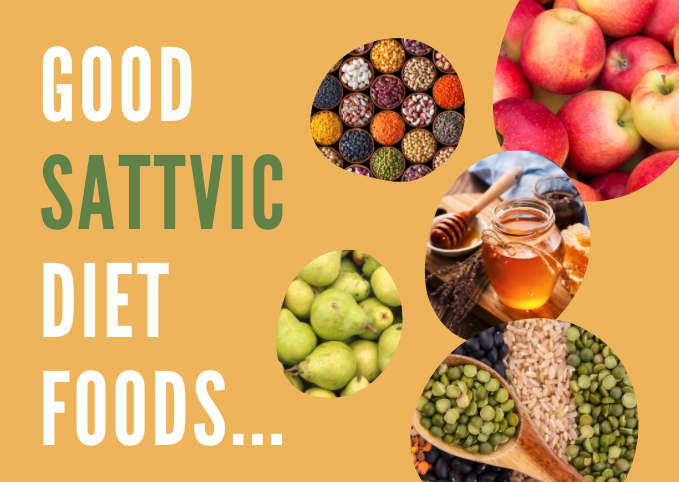Whilst researching Ayurveda, you may have come across the term ‘Sattvic Diet’. But what is a Sattvic diet, and how does it benefit you?
Right, let’s get straight into it, a Sattvic diet is about creating energy and harmony within your body. Actually, the word Sattvic, comes from the word Sattva (which means harmony and clarity). Sattva itself is one of the three energies of the mind – so the Sattvic diet is something to encourage and improve the mind in these ways.
The aim of a Sattvic diet is to creative energy and harmony within your mind (and thus, your body) – and encourage happiness of mind and good mental wellbeing. This sounds great right? Because a healthy mind is such an important aspect to living a happy life.
To put it simply… A Sattvic diet is full of whole foods and pure foods, that together will build mental wellbeing and happiness.
A Sattvic diet will aim to improve your mental clarity, your energy, your focus, and joy, peace and happiness. So, it’s not hard to see why people follow a Sattvic diet when they start looking into Ayurveda. Who wouldn’t want to see an improvement in all those areas of their mental health? In fact, the Sattvic diet is a diet of proof. Most people follow it to experiment and see if it works, and then continue and stick to it, because the results are so tangible and proven, and they can feel the benefits themselves.
What foods are part of a Sattvic diet?
A Sattvic diet is initially all about introducing the highly beneficial foods into you eating habits and routines, and seeing how much good they do, and how much better you feel. Gradually you might transition to eating only Sattvic foods, but this change should be made gradually.
The main foods that make up a Sattvic diet are as follows;
- Ripe fresh fruit (of course!) Think along the lines of pears, apples, plums, mangos, etc)
- Fresh vegetables (green leafy ones are a favorite, alongside seeded vegetables too!)
- Whole grains (like wheat, oats, quinoa and rice)
- Dairy products (you want to look for organic and fresh dairy products, such as milk, ghee, curd and yoghurt)
- Spices (but nothing too stimulating)
- Nuts and seeds
- Various Legumes / lentils / chickpeas and dhals
- Natural sweeteners (honey for example!)
Learning to eat these food in balance with your Ayurvedic dosha type can be where this gets tricky – as you’ll want to make sure you choosing good Sattvic food, as well as foods that are going to keep you dosha in balance.

What foods are off limits on a Sattvic diet?
In the Sattvic diet, there are certain foods that can be ‘over stimiulating’ which it’s best to avoid or cut out. These are referred to as ‘Rajasic foods’ – and that means ‘over agitating’. Rajas is actually the energy of agitation, and so these food can actually encourage or increase negative emotions or habits.
You’ll see, as you read through this list, that the majority of the Rajasic foods are high in salt, or seem to tick one of the following flavor profiles; pungent, bitter, dry, or burning.
So, which foods fall into the category of Rajasic?
- Unripe fruit
- Coffee (caffeine in general)
- Sweets and too much sugar
- Radishes
- Onions
- Chillis and pepper
- Eggs
- Refined white sugar
- Mustards
- Heavily salted foods
As well as Rajasic, there are also Tamasic foods.
Tamasic foods are another food category to steer clear of when following a Sattvic diet. Tamas, is known as the energy of resistance. Tamasic foods are often foods that are decomposed, stale or unclean (which you’ll understand more as we elaborate). Have a think though now, which food might fall into this category! Tamasic foods, eaten out of balance, can make us inert, tired or lazy, so here’s a few to look out for:
- Mushrooms
- Vinegar
- Meat
- Poultry
- Fish
- Fermented foods
- Burnt food
- Fried foods
- BBQ’d foods
- Canned foods
- Processed foods
- Leftovers

What are some easy hacks for following a Sattvic diet?
A great way to start eating according to the Sattvic diet, is to focus on healthy changes and swaps. I’ve outlined some of the most common swaps below – which can take you away from Rajasic foods, and back to the Sattvic diet foods.
- Swap out vinegar for lemon juice (great tips for salads)
- Swap out onions for ginger (great for adding flavour in a different way)
- Swap out eggs (in baking) for baking powder instead
- Swap out meat for pulses or tofu
These easy swaps can make following the Sattvic diet much easier, and you’ll find you’ll discover your own little Sattvic diet hacks the move you research and experiment with Sattvic diet recipes too.
Now, if you’re new to a Sattvic diet, you might not want to eat a wholey Sattvic diet stright away. And remember, many people don’t! Many people simply use the principle of a Sattvic diet to guide their eating habits, and understand more about the foods that encourage different types of behaviour and mental health.
Simply knowing the different types of foods available to you, and their potential affects on your mind, can be a great tool to making small improvements going forwards!





